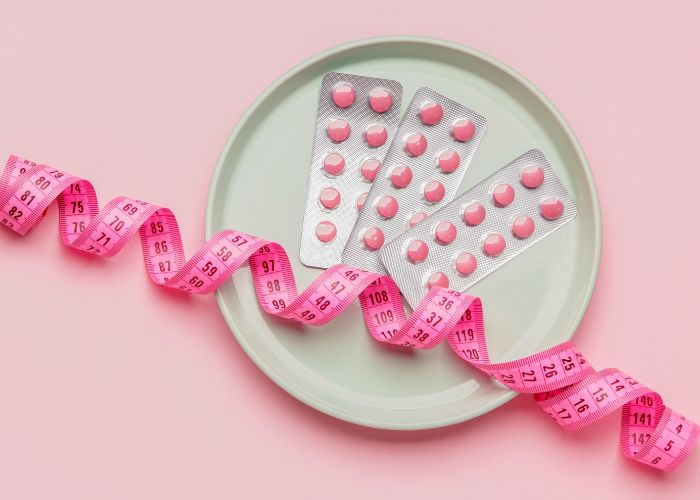The bikini season is slowly coming to an end! This means that our tight clothes that ruthlessly reveal every extra kilo can disappear into the depths of our closets. For some a day of joy, for other a day of despair. Even though body-positivity is an increasingly popular mindset, many women still suffer because of their appearance.
“Love your body” and “all bodies are beautiful” are key messages of the body positivity movement that tries to convince people that their bodies are beautiful, even if they don’t match current beauty standards. The goal is to tackle unrealistic beauty standards and create a powerful self-esteem that doesn’t depend on any norms or units. Body positivity advocates point out that beauty standards are a societal construct and should have no relevance towards self-love and self-esteem. Beauty standards constantly evolve, and it is no surprise that 25.000 years before Christ, a sculpture was created to capture beauty back then – the famous “Venus of Willendorf”! The beauty standards of Marilyn Monroe aren’t that far in the past, and the style “Heroin Chic” (a fad from the 90s coined by pictures of Kate Moss) is the most similar to our current ideals of beauty. Yet, over the past few years, change has been brewing in the world of fashion. Magazines are fighting to get their hands on models such as Winnie Harlow (a Canadian model with the skin disease vitiligo) and “Plus Size” models such as Ashley Graham.
Body positivity represents a noble goal. However, back in 2011, market researchers already knew that four out of five people in German-speaking countries were unhappy with their outward appearance, and nine out of ten said it played a big role for them. Having a strong self-esteem (disregarding any norms) is also pivotal towards mental health, but it shouldn’t veer towards any extremes. Often, clearly overweight individuals are celebrated like popstars because they embody the message of body positivity. But does it really make sense to celebrate a body image that is verifiably connected with countless health problems and consequences?
BMI and obesity
Obesity is a chronic disease and is also known under the term adiposity. Severely overweight patients have a reduced quality of life, and the disease carries a high risk of further complications. Obesity is defined as a BMI of over 30, according to the World Health Organisation (WHO). The BMI is calculated using the ratio between body weight and height. However, this doesn’t take into account a person’s body composition, just their mass. In other words, very muscular individuals also have a high BMI and are therefore classified as “obese”. This problem is quickly solved by taking a look at the ratio of water, fat and muscles within a person. Regardless of how error-prone the BMI is, it still allows experts to make rough estimates regarding individual physical attributes. Besides the analysis of body composition, the WHR (Waist to Hip Ratio) is frequently used. This figure looks at the ratio between the waist and hip, which again provides information about the distribution of fat throughout the body. “Belly fat” is especially stressful on the body! This so-called visceral fat is wrapped around the inner organs and enables the development of countless diseases that ultimately stress and put strain on the body (e.g. diabetes, thrombosis, cancer and Alzheimer’s).
It’s important to note that obesity is far more than just an uncontrollable urge to eat. It is a recognised chronic disease that belongs among hormonal, dietary and metabolic diseases. The Austrian Obesity Society (ÖAG = Österreichische Adipositas Gesellschaft) points out that by 2025, more than 2,7 billion adults worldwide will be overweight. In the summer of 2018, 3,4 million Austrians were already overweight. The consequences of obesity – regardless of any disease -, excessive eating and exaggerated body positivity are all the same. Besides the cardiovascular system, the musculoskeletal system also suffers – especially joints such as the knee, hip and ankle. Moreover, the intervertebral discs over overexerted, resulting in premature abrasion and even herniated discs. Increased sweating, reflux (heartburn), sleep apnoea, varicose veins, gallbladder stones, gout and a fatty liver are all consequences of obesity. Last but not least, it is important to mention that obese individuals have a higher risk of developing malignant tumours which can also harm the intestines. It is, therefore, no surprise that gastrointestinal diseases occur more frequently in obese individuals.
Obesity, stress and nutrition
Being overweight makes the body very busy! It has to move a larger mass and therefore needs more resources. This also results in more stress on our bodies, which eventually can’t cope with these burdens and leads to the above-mentioned consequences. Arthrosis, also know as joint degeneration, is a common comorbidity of obesity and being overweight. Just five kilogrammes of excess weight can double the risk of cartilage degeneration in the knee and increase the risk of knee arthrosis. If the musculoskeletal system can’t work properly, it again results in more stress on the body. Excess weight also severely reduces the regenerative capacities of the body and also leads to more stress sooner or later. Without proper recuperation, our bodies are less adept at coping with stress factors, and so a vicious cycle begins. This means that weight loss is the simplest and most effective way to unburden the body and ease stress.
Mental strain through diets is also something to take into consideration when talking about stress. It is becoming increasingly popular, despite the body positivity movement, to see the intake of food either as a reward or punishment. As a consequence, foods aren’t enjoyed anymore, but instead, they are seen as a necessary evil. The trend “I train to eat – I eat to train” is met with huge excitement within the fitness industry. While some stress about the right composition of their meals to build as much muscle as possible, others stress about counting calories. Both cases, however, juxtapose whether this doesn’t create more stress than necessary.
Intestinal health is the magic word
The opinion that the body itself is to blame for being overweight is becoming increasingly popular. Thyroid changes and problems are often the cause of an unbalanced metabolism and the rising numbers on the scale. However, this is no excuse to gain weight! Obesity – every extra kilo is too much – equals more stress for the body. This also puts more and more focus on the intestines. It is assumed that certain intestinal bacteria (Clostridium ramosum) can actually influence our weight.
You probably also know someone who barely exercises and eats too much (and not balanced either), yet is still skinny and slender. Genetic predisposition is a factor that plays a small role, whereas the intestines and intestinal flora are growing in the spotlight of science.
“One of the important findings reveals that the composition and diversity of the intestinal bacteria differ between lean and obese individuals. The biggest differences can be found between the Bacteroidetes and Firmicutes. The prior dominate the intestines of person’s with a normal weight, whereas the latter strain has the upper hand in the intestines of obese persons. Ideally, these bacteria groups should have a balanced relationship in the intestines. The ratio of these bacteria can be drastically altered in overweight individuals with the intestines containing 2.000 times more Firmicutes than Bacteroidetes, which has a direct effect on the energy metabolism.“
This makes it clear that our intestines need help in obtaining more good bacteria and taking care of them. This is achieved through the right diet. A balanced diet includes the right amount of classic macronutrients (carbohydrates, protein and fat) and micronutrients (vitamins, minerals and trace elements). However, prebiotics and probiotics are often forgotten even though they play an ever bigger role, as mentioned above. The intestines and its flora are a “sensitive ecosystem” that need to be taken care of properly”.
 As a result, OMNi-LOGiC® FIBRE and OMNi-BiOTiC® 6 are tried and tested supplements in a balanced diet. OMNi-LOGiC® FIBRE is perfect for supplying intestinal bacteria with enough vital nutrients. The special fibres that are found in OMNi-LOGiC® FIBRE (maise dextrin and guar gum) allow the intestinal bacteria to function optimally. Their tasks include, for example, absorbing important nutrients from food, the expulsion of toxins that enter the intestines through some foods (e.g. colourants, emulsifiers) and defending our bodies against foreign germs. An especially important task is supporting the bodies’ defence systems, since roughly 80% of these cells are found in the intestines. Fibres are carbohydrates that only offer a minimal amount of energy. Nevertheless, fibres are essential for normal digestion. The intake of fibres transports the food bolus through the intestines, thereby regulating digestion. Fibres make stool softer during constipation and thicker during diarrhoea. The ideal choice for helping the intestines.
As a result, OMNi-LOGiC® FIBRE and OMNi-BiOTiC® 6 are tried and tested supplements in a balanced diet. OMNi-LOGiC® FIBRE is perfect for supplying intestinal bacteria with enough vital nutrients. The special fibres that are found in OMNi-LOGiC® FIBRE (maise dextrin and guar gum) allow the intestinal bacteria to function optimally. Their tasks include, for example, absorbing important nutrients from food, the expulsion of toxins that enter the intestines through some foods (e.g. colourants, emulsifiers) and defending our bodies against foreign germs. An especially important task is supporting the bodies’ defence systems, since roughly 80% of these cells are found in the intestines. Fibres are carbohydrates that only offer a minimal amount of energy. Nevertheless, fibres are essential for normal digestion. The intake of fibres transports the food bolus through the intestines, thereby regulating digestion. Fibres make stool softer during constipation and thicker during diarrhoea. The ideal choice for helping the intestines.
OMNi-LOGiC® 6 on the other hand, supports the intestines with critical “little helpers” that inhabit the intestines from top to bottom. The stress and hectic pace of everyday life expel the bacteria from the intestines. This creates even more mental stress, making it easier for foreign germs to settle down in our intestines and multiply. This can result in a lack of “good” bacteria, dysfunctional expulsion of harmful substances and toxins, and slow intestines. The intake of probiotics offers the appropriate support for the intestines and can reduce stress factors.
A balanced diet instead of stress!
Many factors need to be taken into account during a balanced diet. These include, among others, life circumstances, current occupational situation, amount of exercise and available time. There is no “one size fits all” approach. However, one concept that always applies is that diet and food intake should not cause any stress. Diets and their often associated restrictions usually cause more stress than necessary. These dietary restrictions then arise during the first visit to a restaurant and can cause stress. Nevertheless, many restaurants and venues have adapted for special types of diets!
Weight-loss diets have clear rules. In a low-carb diet, the intake of carbohydrates should be held to a minimum, whereas the 1:0 diet allows you to pig out on the one day and eat nothing the next. The basic premise in losing weight, however, is always the same – you should eat in a caloric deficit. In other words, eating fewer calories than you burn. This is often associated with the famous calory counting, the practice of weighing foods and calculating the total sum of calories. This often leads to more stress than pleasure and turns the dieter into scale puppet. This is why so many weight-loss diets fail and result in the so-called Yoyo-effect.
Intermittent fasting, on the other hand, allows the body and intestines to recover at just the right times (sticking to the motto “everyone needs a break once in a while“) while receiving enough nutrients, despite restrictions. There are also different methods of practising intermittent fasting. The most common option is 16:8 fasting. Basically, individuals fast for 16 hours a day and eat for the other 8 hours. 5:2 fasting is also very popular. Here, individuals eat normally for 5 days a week and eat very few calories on the remaining 2 days. Previous findings in studies reveal that intermittent fasting has a positive effect on health and weight loss. Although there are only very few studies due to the variety of methods, data shows that these diets barely affect fat-free mass.
Another very popular trend is intuitive fasting. Here, there are no restrictions that you have to adhere to. Instead, you should rely on your own intuition and simply listen to your body without any rules. As a result, this concept improves your relationship with food. Naturally, this has a very positive effect on mental health – and all of the associated stress relief when eating. However, this strategy also poses a big risk for people who have forgotten how to correctly interpret their body’s own signals. This can result in rapid weight gain if the needs of the body are misinterpreted.
Conclusion
As a rule of thumb, you should always try to avoid negative stress (distress). Whether in the form of mental strain or any other type of stress. Stress lastingly damages the body and makes it age quicker. Obesity and excess weight should always be avoided since every extra kilo puts the body and joints under more strain. Exercise should become an integral part of your everyday life, no matter whether you want to gain or lose weight! If in doubt, always consult an expert (dietician, nutritionist, etc.) about a balanced diet to recognise and meet your individual needs. The correct use of prebiotics and probiotics can help reduce “stress” on the body and improve your general wellbeing. Listen to your gut feeling, eat without stress and do plenty of exercise. Your body and soul will thank you for it.
About the author

Dipl.-Ing. Anna-Lena Kollos, MA (a.k.a Lela) began her education as an athletics trainer after her studies (Biotechnology, Food Technology and Public Affairs), completing all the courses with distinction by autumn 2019. Thanks to her work as a personal trainer and communications consultant with a focus on health-related topics, she closely analyses her gut feeling. As such, she focuses on a holistic and long-term approach, which is necessary to achieve her personal goals – in training, as well as communication. Lela has paid close attention to her gut feeling for many years and has trusted it on many occasions. Because of her diverse education and experiences, the personal trainer can rely on her vast knowledge and Know-How.
Photo credit: Marie&Michael Photography





























